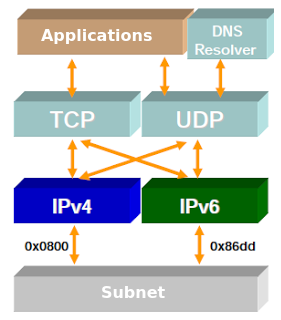IPv4 to IPv6 - Basic Transition Mechanisms
The total Internet transition from IPv4 to IPv6 in the short term is impossible, due to the size of the Internet and the large number of users currently using IPv4, so a certain time to make the full transition to IPv6 Internet is unthinkable.
However, there is no problem in that the transition is not carried out immediately, since both IPv4 and IPv6 protocols can coexist without any problem. Rather, it has been thought that this transition should be done gradually and efficiently, where in the initial phase nodes have support for both protocols simultaneously, then over time, have an IPv6 Internet infrastructure and leaving on one hand the protocol IPv4.
Likewise these transition mechanisms are designed to be used by IPv6 hosts and routers that need to interoperate with IPv4 hosts and utilize IPv4 routing infrastructures. Many nodes are expected to need support for a long time and perhaps indefinitely. However, IPv6 can also be used in environments which do not require interoperability with IPv4. Nodes designed for such environments need not use or implement these mechanisms.
The goals of the transition of the Internet from IPv4 to IPv6 are:

Nodes with both protocol stacks are called IPv6/IPv4 nodes. By using this mechanism double stacks, will have an address in each stack. These IPv4 and IPv6 addresses can that are related among themselves, but not required to implement this method, so these directions may not have any relationship.
To obtain the IPv6 address, the nodes can use stateless autoconfiguration mechanisms or by DHCPv6, and to obtain the IPv4 address, you can use the standard mechanisms or protocols as DHCPv4, boot protocol (BOOTP), Resolution Address Reverse Protocol (RARP) or manual configuration on the node of the IPv4 address.
For these IPv4 and IPv6 are related in some way within each node, you can make use of IPv6 addresses that are compatible with IPv4. An address of this type is in its high-order 96 bits (those on the left) a value of 0:0:0:0:0:0 and the low-order 32 bits (those on the right) an IPv4 . Thus, when used, it could have on the IPv6 stack, the address includes the 96-bit value 0:0:0:0:0:0 more IPv4 address, and the IPv4 stack would address IPv4 is in the lower order 32 bits of the IPv6 address.
However, there is no problem in that the transition is not carried out immediately, since both IPv4 and IPv6 protocols can coexist without any problem. Rather, it has been thought that this transition should be done gradually and efficiently, where in the initial phase nodes have support for both protocols simultaneously, then over time, have an IPv6 Internet infrastructure and leaving on one hand the protocol IPv4.
Likewise these transition mechanisms are designed to be used by IPv6 hosts and routers that need to interoperate with IPv4 hosts and utilize IPv4 routing infrastructures. Many nodes are expected to need support for a long time and perhaps indefinitely. However, IPv6 can also be used in environments which do not require interoperability with IPv4. Nodes designed for such environments need not use or implement these mechanisms.
The goals of the transition of the Internet from IPv4 to IPv6 are:
- The coexistence of IPv4 and IPv6, IPv4 completely disappear until sometime.
- The use of hosts and routers with IPv6 support must be distributed over the Internet in a way thatis simple and progressive.
- Reducing interdependencies during the transition.
- The transition to network administrators and end users should be easy to implement.
- Dual Stack Transition Mechanism
- The most obvious way, so that a node can communicate with nodes that use only IPv4 or only IPv6, is the simultaneous use of both protocols that node, in separate stacks, a node with either protocol can send and receive data from other nodes regardless of the protocol version support such nodes.

Nodes with both protocol stacks are called IPv6/IPv4 nodes. By using this mechanism double stacks, will have an address in each stack. These IPv4 and IPv6 addresses can that are related among themselves, but not required to implement this method, so these directions may not have any relationship.
To obtain the IPv6 address, the nodes can use stateless autoconfiguration mechanisms or by DHCPv6, and to obtain the IPv4 address, you can use the standard mechanisms or protocols as DHCPv4, boot protocol (BOOTP), Resolution Address Reverse Protocol (RARP) or manual configuration on the node of the IPv4 address.
For these IPv4 and IPv6 are related in some way within each node, you can make use of IPv6 addresses that are compatible with IPv4. An address of this type is in its high-order 96 bits (those on the left) a value of 0:0:0:0:0:0 and the low-order 32 bits (those on the right) an IPv4 . Thus, when used, it could have on the IPv6 stack, the address includes the 96-bit value 0:0:0:0:0:0 more IPv4 address, and the IPv4 stack would address IPv4 is in the lower order 32 bits of the IPv6 address.
0 Comments:
Post a Comment